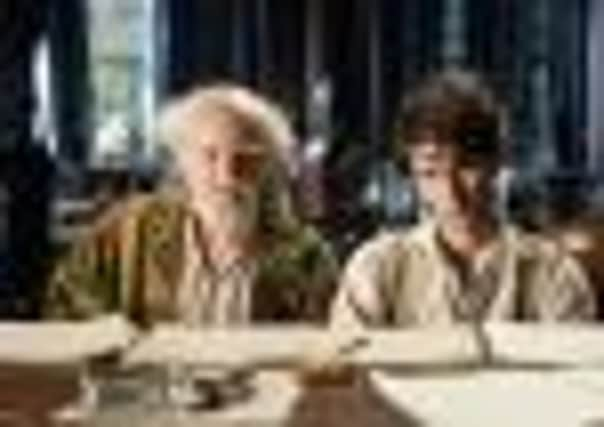Film review: Cloud Atlas (15)


CLOUD ATLAS (15)
DIRECTED BY: ANDY WACHOWSKI, LANA WACHOWSKI, TOM TYKWER
STARRING: TOM HANKS, JIM BROADBENT, JIM STURGESS, HUGH GRANT, JAMES D’ARCY, XUN ZHOU
STAR RATING: * * *
What a strange beast Cloud Atlas is. Often bold and wildly ambitious, at times both wilfully and unintentionally silly, occasionally moving, always beautiful, rarely dull, it’s large-scale mainstream moviemaking of a type that could be just as easily be celebrated or castigated as a filmmaking folly.
Advertisement
Hide AdGoing purely on its commercial performance in the US last year, one could easily dismiss it as an example of the latter, and yet there are plenty of things about it that place it firmly in the former camp, not least directors Tom Tykwer and Andy and Lana Wachowski’s collective ability to capture the spirit of David Mitchell’s out-there source novel without losing control of its time-jumping, multi-narrative, somewhat metaphysical story of interconnected souls traversing the universe in free and enslaved states.
Indeed, the film is a surprisingly faithful adaptation, to the point where the frustrations of the book – the impenetrability of some of the more radically written sections, the occasionally indulgent narrative trickery required to tie it all together – become the frustrations of the film. And yet the converse of this is also true: the novel’s sweep, scale and divergent tones ensure the film is always engaging, if not always cohesive.
One significant change Tykwer and the Wachowskis have made is to ditch the sequential, pyramidal structure of the novel’s interlocking narratives in favour of a more cinematically friendly cross-cutting approach. The film thus begins with an audacious and bewildering series of short, sharp, chronology scrambling scenes that take us back and forth between a primitive post-apocalyptic future world centuries hence, the South Pacific of 1849, 1970s San Francisco, contemporary London, Edinburgh in the 1930s, and 22nd-century Seoul. Bombarding us with various cliffhangers and events from the larger story, we’re also gradually introduced to its myriad protagonists and supporting characters, many of whom are played by the same actors moving from one story to the next.
This can make for distracting and disconcerting viewing, not least when Tom Hanks is involved. Not the most transformative of actors, he takes the lead in the post-apocalyptic section as the doyen of a tribal clan under threat from some Mad Max-style savages. But he also pops up in a variety of latex-caked guises as a malevolent ship’s doctor, an Irish gangster-turned-author, and a corrupt Edinburgh hotel manager (his Scottish accent is much better than his Irish one, which frequently wavers towards Cockney). Elsewhere Halle Berry supplements her turn as a sleuthing reporter investigating a nuclear power plant cover-up in San Francisco by playing – among other roles – a futuristic space traveller searching for the remains of a lost technological society. Then there’s Jim Broadbent, who when he’s not taking the lead in the film’s sole contemporary tale as a bankrupt book-publisher who ends up imprisoned in an old folks home, turns up as a nasty and decrepit Edinburgh-based composer trying to subjugate his more talented amanuensis (Ben Whishaw).
And on it goes, with multiple roles too for the other members of the huge cast – among them Jim Sturgess, Hugh Grant, Hugo Weaving, Keith David, Susan Sarandon and James D’Arcy. The connections are frequently oblique (only James D’Arcy plays the same character in two different stories), but their collective presence helps reinforce the slightly hippy-dippy cosmic nature of the overall story, which at various points reveals that each of the lead characters has the same comet-shaped birth mark.
What it all means, of course, is a different matter. Each story is on some level about the eternal battle between the weak and the strong, and it’s easy to see what drew the Wachowskis in particular to this idea given the themes of The Matrix trilogy. The futuristic thread set in “Neo Seoul” even revolves around an uprising of robot serfs against their thoughtless human exploiters, which was pretty much the back-story for their ground-breaking 1999 sci-fi classic.
Advertisement
Hide AdNevertheless, it’s actually Run Lola Run director Tom Tykwer’s strands that are the most entertaining, with central Glasgow’s vertiginous city streets doubling up nicely for San Francisco during a shoot-out involving Berry’s journalist Luisa Ray, and Edinburgh providing a suitably melancholic backdrop for the 1930s-set tale featuring Ben Wishaw’s suicidal gay composer. (Tykwer only just gets away with the comedy nationalism of another Scottish-set scene – involving a pub fight in the midst of a Six Nations match – thanks to the caper-like tone deployed in the rest of its contemporary-set segment.)
Despite all these thematic and literal connections, however, Cloud Atlas lacks the kind of mind-blowing ending necessary to make everything really resonate. What we get instead boils down to a sort of We Are the World plea for love and understanding. And yet, for the most part, the film succeeds as a big, goofy, overblown, but endearingly sincere attempt to do something different. It may be a folly, but it’s a worthwhile one.